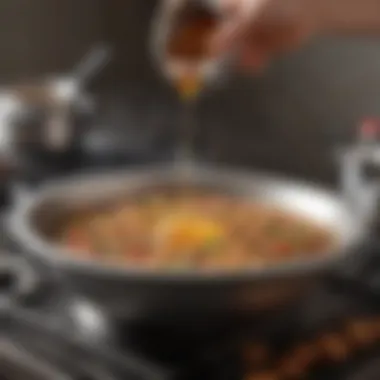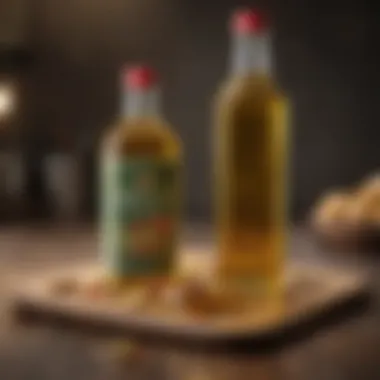Effective Methods for Responsible Cooking Oil Disposal


Intro
The accumulation of used cooking oil is a reality many households face. Proper disposal is crucial not just for maintaining hygiene in the kitchen but also for mitigating potential environmental hazards. When cooking oil is disposed of irresponsibly, it can clog drains and contribute to pollution in waterways. By understanding effective methods for disposing of cooking oil, individuals contribute to a more sustainable future.
The goal of this article is to delve into various strategies that promote responsible disposal of cooking oil. Emphasizing recycling, reuse, and local services, this guide offers practical solutions for both home and community.
Importance of Proper Disposal
With increased awareness regarding environmental conservation and public health, the urgency of effective cooking oil disposal cannot be overstated. Improper disposal can lead to serious consequences, including water contamination and damage to local wildlife. Thus, employing suitable methods for disposal benefits both personal and ecological health.
This article will cover key aspects, including:
- Recycling options,
- Reuse practices,
- Local disposal services,
- Home solutions for safe disposal.
"Understanding waste management is crucial in today’s environmentally conscious society."
By the end of this guide, readers will have a comprehensive understanding of how to handle used cooking oil responsibly.
Understanding the Importance of Proper Cooking Oil Disposal
Disposing of cooking oil need careful consideration. It plays a crucial role in protecting our environment and safeguarding public health. Used cooking oil can pose significant hazards if not controlled properly. Many people may not realize that the disposal method they choose affects local ecosystems, waterways, and even communal sanitation systems. With awareness, individuals can implement better practices that minimize negative repercussions typified by careless disposal.
Environmental Impact of Improper Disposal
Improper disposal of used cooking oil can lead to various environmental issues. When poured down sinks or toilets, it can clog pipes and cause costly plumbing issues. More importantly, it harms water quality when it contaminates rivers and streams. The oil can create a thin layer on the surface of the water, hindering oxygen exchange, which can kill aquatic life. Moreover, the toxins from decomposing oil can seep into the soil, affecting plants and organisms. Thus, understanding how cooking oil disposal impacts the ecosystem is vital for informed decision-making.
Health Risks Associated with Improper Disposal
The health implications of improper cooking oil disposal are often underestimated. When oil contaminates water sources, it not only affects aquatic wildlife but also poses risks to human health. Consuming water or food contaminated with oil can lead to serious illnesses. Additionally, the degradation of oil residues in landfills can emit harmful substances that contribute to air pollution. Unsanitary conditions caused by improper disposal can attract pests, leading to further health concerns. Ensuring proper disposal of cooking oil protects health and maintains safe living environments.
Identifying Used Cooking Oil
Understanding how to identify used cooking oil is a crucial step in the responsible disposal process. Many people often think of cooking oil as something that can simply be thrown away after use. However, this misconception contributes to improper disposal practices that can harm the environment. Identifying cooking oil in its used state helps you make informed decisions about its disposal, thereby minimizing health risks and environmental impact.
Characteristics of Used Cooking Oil
Used cooking oil exhibits several telltale characteristics that signal it is no longer suitable for culinary use. Firstly, the oil often darkens in color, transitioning from a clear or light hue to a much deeper shade. This change indicates the degradation of the oil due to heat exposure and contamination from food particles.
Secondly, a rancid or off-putting odor may arise from used oils, which can deter even the most avid cooks. This smell is a clear indicator that the oil has oxidized and likely contains harmful compounds that could affect food safety. Moreover, the texture of used cooking oil can change significantly; it may become thicker or more viscous as it breaks down with repeated heating. If the oil has any floating debris or food particles, it is also a sign that it is no longer reusable. Recognizing these characteristics can assist anyone in determining whether cooking oil is fit for disposal or if it has potential for reuse.
Signs It is Time to Dispose of Cooking Oil
Several factors play into the decision of when to dispose of used cooking oil. One primary sign is the oil's color and smell, as already mentioned. If visual and olfactory assessments indicate a significant change, it is likely time to dispose of it. Another critical pointer is the number of times the oil has been used. Typically, oil that has been heated multiple times, especially with breaded or heavily seasoned foods, is more prone to spoilage.
When cooking oil starts to smoke at lower temperatures during heating, it's a definitive sign of its depletion. This smoking point decreases with reuse, suggesting degradation of quality.
Lastly, if you have any doubts or concerns about the safety of the cooking oil, it is better to err on the side of caution. Proper disposal should be prioritized over potential health risks associated with using oil that may have expired.
"Proper identification of used cooking oil not only safeguards health but also promotes eco-friendly disposal practices."


By being attentive to these signs and characteristics, individuals can significantly reduce the negative impacts associated with improper cooking oil disposal.
Methods for Disposing of Used Cooking Oil
Disposing of used cooking oil requires careful consideration. Understanding the methods for safe disposal is crucial not just for individual practices but also for social responsibility. When disposed of correctly, it reduces waste, minimizes environmental damage, and promotes recycling. Improper disposal can contribute to clogged drains, pollution, and health hazards. Hence, knowing various methods effectively empowers individuals to make better choices for both their household and the community.
Recycling Used Cooking Oil
Finding Local Recycling Facilities
Finding local recycling facilities for used cooking oil is an effective way to manage waste. Many cities have dedicated programs aimed at collecting cooking oil for recycling. This offers a sustainable solution by converting waste into usable products like biodiesel. A key characteristic of these facilities is their community-oriented approach, often encouraging residents to participate in environmentally friendly practices.
Additionally, local recycling options may include curbside pickup or designated drop-off points. The unique feature of local recycling facilities is their ability to process large quantities of oil, reducing the likelihood of environmental contamination. However, the effectiveness can vary greatly depending on local infrastructure and public awareness.
Understanding the Recycling Process
Understanding the recycling process for used cooking oil is essential for maximizing its potential benefits. The oil undergoes purification and conversion into biodiesel or other renewable products. This process typically involves filtering, dewatering, and potentially undergoing chemical reactions to change its composition.
A key characteristic of this process is its role in reducing reliance on fossil fuels. By recycling oil, communities can contribute to cleaner energy solutions. Its unique aspect is that it also helps reduce landfill waste. Still, this process may require specialized facilities. Therefore, knowing where and how the oil can be effectively recycled is crucial.
Reusing Cooking Oil
Storage Tips for Reusing Oil
Proper storage is vital when reusing cooking oil. To maximize its lifespan, it should be strained and kept in a dark, cool place to prevent spoilage. An important benefit of reusing oil is that it can save money and resources. This practice reduces waste, especially in households that frequently use oil for frying.
A unique feature of oil storage is that using airtight containers can help maintain its quality. However, it should not be reused indefinitely. Monitoring for off smells or changes in color is essential to determine if oil is still usable.
Cooking Techniques for Reused Oil
When it comes to cooking techniques using reused oil, it is essential to understand temperature control. Cooking at the right temperature can help minimize the formation of harmful compounds. For instance, oil used for deep frying may be reused for sautéing, as lower temperatures may prolong its life.
A significant advantage here is the versatility it presents for recipes. However, not all food types are suitable for reuse. The unique challenge is knowing which kinds of oil can safely be reused based on their previous use.
Disposing of Cooking Oil in Trash
How to Solidify Oil for Disposal
If recycling or reusing is not an option, solidifying the oil for trash disposal is a practical method. This can be done using absorbent materials like cat litter or sawdust to absorb the liquid and turn it into a solid. Solidifying the oil reduces the risk of leakage and prevents contamination of the trash stream.
A characteristic feature is how easy and quick the process is. However, environmental implications still exist, as this method does not address the waste issue effectively. It’s more of a temporary solution than a long-term fix.
Best Practices for Trash Disposal
Following best practices for trash disposal is important when dealing with used cooking oil. First, ensure the solidified oil is sealed in a container before placing it in the trash. Secondly, always check with local waste management regulations to comply with laws.
A unique aspect of adhering to these practices is that it offers a way to be responsible even when dealing with waste. Although this is the least favorable option compared to recycling, it provides a safer alternative to pouring oil down drains.
Composting Cooking Oil
Can You Compost Cooking Oil?


Composting cooking oil is a relatively less-known method but can be effective in certain contexts. While small amounts of vegetable-based oil can be acceptable, excessive amounts can disrupt the balance of the compost. The advantage of this method is that it can contribute to organic matter in the compost heap, enriching the soil.
The key point here is to ensure that oil is not saturated, as it will lead to problems with composting and attract pests. Furthermore, understanding what types of oils are suitable for composting is crucial.
Composting Oil: A Step-by-Step Guide
For those interested in composting oil, a step-by-step approach is helpful. Start with a small amount, and mix it with carbon-rich materials such as dry leaves or straw to create a balanced compost mix. Monitor the compost regularly, ensuring that the mixture is aerated and maintains moisture.
The significant feature of this method is its potential for soil enrichment. However, improper mixing could lead to a rancid smell or inhibit microbial action. Therefore, care must be taken to maintain the proper ratios and conditions.
Local Regulations on Cooking Oil Disposal
Understanding local regulations is crucial for responsible cooking oil disposal. These regulations vary widely depending on location, impacting how individuals and businesses handle used oil. Adhering to local laws is not only a legal obligation but also a significant step towards environmental conservation. Governments implement these regulations to address public health concerns and to minimize ecological impact. When disposed of improperly, cooking oil can lead to serious environmental issues, including water pollution and harm to wildlife.
By following local disposal guidelines, individuals can contribute positively to their community's efforts in waste management and conservation. It can also provide peace of mind knowing that one is compliant with legal and environmental standards.
Understanding Local Disposal Guidelines
Local disposal guidelines often include specific instructions on how and where to dispose of cooking oil. These guidelines can be found through local government websites or waste management departments. Common elements within these guidelines include:
- Collection Centers: Many areas designate specific locations for cooking oil recycling. These centers are equipped to handle the oil safely, preventing it from reaching landfills or water systems.
- Scheduled Pickups: Some jurisdictions may offer scheduled pickups for household cooking oil. This can simplify the disposal process for residents, ensuring they do not accidentally discard oil improperly.
- Composting Recommendations: In some cases, there may be guidelines around composting small quantities of cooking oil, particularly if it is vegetable-based. Understanding these nuances can empower individuals to make informed choices.
Staying informed about these regulations can significantly help individuals contribute to a cleaner environment.
Consequences of Non-Compliance
Ignoring local disposal regulations can lead to a range of consequences, both legal and environmental. Here are key implications:
- Fines and Penalties: Many localities enforce fines for improper disposal. This can be particularly costly for commercial establishments.
- Environmental Damage: Failure to dispose of oil correctly contributes to environmental pollution. Used cooking oil in water bodies can lead to harmful effects on aquatic ecosystems.
- Public Health Risks: Improper disposal methods can create health hazards in the community. Contaminated water supplies can lead to serious health issues for residents.
- Negative Community Impact: Non-compliance can tarnish the reputation of local businesses and lead to increased community scrutiny and pressure to address waste management issues.
"It is essential to recognize that the choice of disposing of cooking oil improperly has ramifications that extend beyond just the individual or business involved."
Understanding and adhering to local regulations ensures that personal practices do not negatively impact the community or the environment at large.
Alternative Uses for Cooking Oil
Exploring alternative uses for cooking oil is an essential aspect of sustainable kitchen practices. Instead of disposing of used oil without thought, recognizing its potential can have various benefits. One important consideration is reducing waste. By finding new purposes for used cooking oil, individuals contribute to a circular economy and help alleviate some of the environmental impact associated with disposal. Additionally, it offers practical solutions in daily life, often requiring minimal resources and effort.
DIY Projects Using Cooking Oil
Used cooking oil can serve as a key ingredient for several DIY projects. Here are some ideas:
- Homemade Soap: Combine used cooking oil with lye, water, and essential oils to create unique soap bars. This process allows for the recycling of oil while producing a useful household item.
- Scented Candles: Melt down solidified used cooking oil, mix it with wax, and add fragrance to craft customized candles. This approach provides an alternative to commercial candles, which may contain harmful additives.
- Wood Furniture Polish: Mixing used oil with vinegar can yield an effective wood polish. This simple formulation cleans and nourishes wooden surfaces, restoring their appearance without the need for harsh chemicals.
- Rust Preventative: A thin layer of oil applied to metal tools can help prevent rust, safeguarding them for future use. This practice also reduces the number of hazardous waste items created when discarding old tools.
While engaging in these DIY projects, it is crucial to ensure the oil is free of food particles and contaminants. Proper cleaning and filtering of the oil will enhance the efficacy of these projects.
Beneficial Uses in Gardens and Pest Control
Using cooking oil in gardens can provide notable benefits. Here are some examples:
- Plant Feeding: Cooking oil can direcly enhance soil quality. Mixing the oil with compost or organic fertilizer can provide beneficial micronutrients to plants.
- Pest Repellent: Used cooking oil can serve as a natural pest repellent. Mixing it with water and a few drops of dish soap creates an effective spray against common garden pests. This is a safer alternative to chemical pesticides and benefits pollinators.
- Fungicide: A diluted solution of used cooking oil discourages fungal growth on plants. Spraying this mixture on affected areas can help restore plant health without resorting to commercial fungicides, which often harm beneficial organisms.


One must be cautious when applying oil near edible plants. Excessive use may lead to oily residue on leaves, affecting photosynthesis. Careful and moderate application will yield positive effects while minimizing any negatives.
"Using cooking oil creatively not only diversifies its application but also fosters environmentally conscious behavior."
The End
Overall, recognizing alternative uses for cooking oil can vastly reduce waste and promote sustainability. From crafting DIY projects to enhancing garden productivity, there is much potential beyond disposal. Individuals can appreciate the value of used cooking oil is if they explore various options that contribute positively to their home and environment.
Best Practices for Future Cooking Oil Management
Managing cooking oil effectively is crucial for both sustainability and health. Adopting best practices helps reduce waste, minimizes environmental impact, and ensures the quality of oil used in cooking. Understanding how to manage cooking oil not only benefits individual kitchens but also contributes to larger environmental efforts.
Tips for Reducing Oil Waste
To minimize oil waste, several practical tips can be applied in the kitchen.
- Measure Oil Usage: Before cooking, determine how much oil is actually needed. Measuring reduces excess and encourages mindful cooking.
- Choose Cooking Methods Wisely: Consider using methods that require less oil, such as grilling or steaming. This reduces the overall quantity of oil used.
- Regularly Check Inventory: Keeping an eye on oil inventory leads to better consumption. Use older oil first to avoid waste.
- Store Oil Correctly: Proper storage can prolong oil life. Keep it in a cool, dark place to prevent it from degrading.
"Reducing oil waste is not just about saving money, it’s a step towards a more sustainable future."
Maintaining Oil Quality for Extended Use
Preserving the quality of cooking oil ensures it remains safe and effective for cooking. Here are key practices to maintain oil quality:
- Strain Oil After Use: After frying, strain the oil to remove food particles. This helps to keep the oil cleaner longer.
- Monitor Color and Smell: Regularly check the oil for off smells or darkening color, which can indicate that it has gone bad.
- Limit Heating: Avoid overheating oil, as it can damage its structure, leading to unhealthy compounds. Always choose a suitable oil for the cooking method employed.
- Store in Small Containers: If using oil intermittently, consider storing it in smaller containers. This limits exposure to air and light.
By following these practices, consumers can effectively manage cooking oil in a way that aligns with environmental principles and health standards. Each step taken to reduce waste or maintain quality contributes significantly to a responsible approach to cooking oil management.
Resources for Responsible Oil Disposal
Understanding how to properly dispose of cooking oil is essential. Resources play an important role in ensuring that used oil does not harm the environment or public health. They guide individuals to efficient disposal methods, fostering a culture of responsible waste management.
By utilizing available resources, individuals can significantly reduce their carbon footprint. These resources can also facilitate community engagement by promoting initiatives that encourage recycling and proper disposal of cooking oil.
The accessibility of disposal options can influence an individual's decision to act. Knowing where to go, or whom to contact, provides the necessary support to make responsible choices regarding cooking oil.
Online Platforms for Finding Disposal Centers
Many websites now serve as platforms for locating disposal centers and recycling facilities. Search engines or local government websites often provide direct links to these resources.
One can use a few simple steps to find these centers:
- Search Locally: Type "cooking oil disposal near me" into a search engine.
- Check Local Government Websites: They often have lists of accepted materials and local recycling guidelines.
- Utilize Apps: Some mobile applications allow users to connect with nearby recycling services.
These platforms often provide information about hours of operation, accepted materials, and specific instructions for disposal. Engaging with these resources facilitates environmentally sound practices.
Community Initiatives Focused on Oil Recycling
Community initiatives are crucial in promoting the recycling of cooking oil. Many local organizations, environmental groups, and non-profits partner to create events focused on recycling surplus cooking oil.
Here are some benefits of community initiatives:
- Increased Awareness: Events increase public knowledge about the effects of improper disposal.
- Convenience: Organized drives often come to neighborhoods, making it easy for residents to participate.
- Collective Impact: When communities act together, they make a more significant impact on the environment.
Local community initiatives not only promote responsible oil disposal but also foster community spirit and engagement.
These events can include collection days, workshops on proper disposal methods, and partnerships with local businesses. Participating in these initiatives increases the likelihood of proper cooking oil disposal while supporting sustainability in the community.















